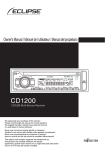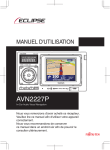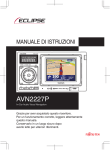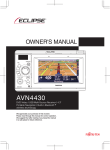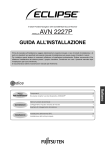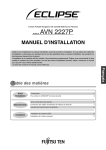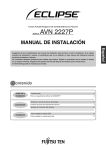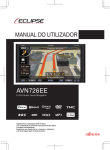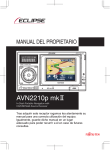Download Eclipse - Fujitsu Ten AVN2227P Car Stereo System User Manual
Transcript
OWNER'S MANUAL
AVN2227P
In-Car Audio Visual Navigation
We appreciate your purchase of this receiver.
Please read through this manual for correct operation.
We suggest that after reading it you keep this manual
in a safe place for future reference.
For your safety when using the AVN2227P
Warnings and caution notices, illustrated below, are posted throughout this manual as well as on the AVN2227P. They
show the safe and correct ways to handle the product so as to prevent personal injury to you and others, and to avoid
property damage.
Before reading through the manual, take the time to read through this section and familiarise yourself with the
important information it contains.
Warning
This notice indicates a situation in which incorrect handling or failure
to observe the notice might result in death or serious personal injury.
Caution
This notice indicates a situation in which incorrect handling or failure
to observe the notice might result in personal injury or may result
solely in damage to property.
Please read all material, such as manuals and warranties, that has come with the product.
Eclipse will not be liable for unsatisfactory product performance due to failure to follow these instructions.
WARNING
● Do not modify this system for any use other than that specified herein. Also, do not deviate from the installation
procedures described herein; Eclipse will not be held liable for damage including, but not limited to, serious
injury, death or property damage resulting from installations that enable unintended operation.
● This main unit requires 12V DC and should only be installed in a vehicle with a 12V negative ground electrical
system. Any other installation may cause a fire or other severe damage to the main unit and the vehicle.
● Never install this main unit where it will interfere with the safe operation of the vehicle. Never block the drivers'
view. Do not install the main unit where it may interfere with the operation of the brakes, the steering or any
safety unit, including seat belts and air bags.
● Before drilling holes in a vehicle for installation, you must confirm the locations of pipes, tanks, electrical wiring,
and other vehicle systems and components to ensure that there will be no interference or contact. You must
also implement rust prevention and leak prevention measures in the drilling area. Otherwise, fire or electric
shock could occur.
● When installing the main unit do not remove or alter the existing vehicle fasteners, including nuts, bolts, screws,
clips, and fittings. Never detach, move or alter existing vehicle wiring, including electrical grounds and straps.
Alteration of existing vehicle components may make the vehicle unsafe to operate.
● Before installation, remove the negative (-) battery terminal to prevent shocks, electrical arcing, fires, and
damage to vehicle wiring and the main unit you are installing.
● Secure wiring with tape or plastic ties so that wires do not interfere with vehicle operation, including the brake
pedal, gear lever and steering. Position wires so that they will not be rubbed, abraded, or damaged by moving
vehicle components, including power seats.
● To avoid main unit and vehicle damage, including fire, never supply power to an installed main unit in a way that
will overload the capacity of an existing vehicle circuit. Never leave a power supply wire or connection
uninsulated. Always install supplied fuses, circuit breakers, and relays.
● Air bags are vital safety devices. Never install a main unit in a way that will alter air bag wiring or interfere with
air bag deployment. Air bags must function properly in the event of an accident.
● When installation is complete, test all vehicle electrical systems for proper operation, including the lights, horn,
brake lights, and emergency flashers.
● For your protection, never use a power drill without safety glasses or goggles. Debris or broken drill bits may
cause severe eye injuries, including blindness.
● Use electrical tape to insulate the ends of all wires, even if they are not used. Proper insulation prevents arcs,
electric shocks and fires.
● Some main units use batteries. Never install main units where young children can get access to batteries. If a
battery is swallowed, seek medical attention immediately.
● When the vehicle is moving, never take your eyes off the road to make adjustments to the main unit. You must
pay attention to the road to avoid accidents. Do not let the operation or adjustment of the main unit distract you
from proper vehicle operation.
● The driver should not look at the screen while driving. Accidents may result if you are not paying attention to the
road ahead.
WARNING
● Do not put foreign objects in the disc loading slot or USB input terminal. Fires or electric shocks may result.
● Do not disassemble or alter this main unit. Accidents, fires or shocks may result.
● Do not let water or foreign objects enter the internal parts of this main unit. Smoke generation, fires or electric
shocks may result.
● Do not use the main unit when it is broken (the screen is not lit or no sound comes out). Accidents, fires or
electric shocks may result.
● Always replace fuses with fuses of identical capacity and characteristics. Never use a fuse of a higher capacity
than the original. Using the wrong type of fuse may cause a fire or severe damage.
● If a foreign object or water enters the main unit, smoke comes out, or there is a strange odour, stop using it
immediately, and contact your dealer. Accidents, fires, or electric shocks may result if you continue to use it in
these conditions.
● The driver should not change the CD or USB memory while driving, as accidents may result if you are not paying
attention to the road ahead. First stop the car at a safe location and then proceed.
● Plastic bags and wrappings may cause suffocation and death. Keep away from babies and children. Never put
bag over your head or mouth.
CAUTION
● Wiring and installing this main unit requires expertise and experience.
Professional installation is
recommended. Consult your dealer or a professional installer. Incorrect wiring may damage the main unit or
interfere with safe vehicle operation.
● Use only the accessory parts specified. Using other parts may cause damage to the main unit or cause parts to
fall or fly off the main unit.
● Do not install the main unit in places where it may get dew condensation on it (around the air conditioning hose,
etc.), come into contact with water, or in conditions of high moisture, dust or oily smoke. If water, moisture, dust
or oily smoke enters this main unit, smoke generation, fires or malfunctions may result.
● Avoid installing the main unit in places where it cannot be fastened securely or where there are strong
vibrations. Also, if you are going to install the main unit with double-sided tape, first wipe away dirt and wax from
the installation area. Otherwise, the main unit may come loose due to vibration while driving, interfering with
driving and resulting in traffic accidents or injuries.
● Do not install the main unit in places exposed to direct sunlight or where it will be hit directly by hot air from the
heater. This may increase the temperature of the interior of the main unit, resulting in fires and malfunctions.
● Do not block the fan, heat sink or vents of this main unit. When a fan, heat sink or vent is blocked, the interior
overheats, and fires may result.
● Connect the main unit as specified in the installation manual. If it is not connected normally, fires or accidents
may result.
● When installing in vehicles equipped with air bags, check the manufacturer's cautions regarding operation
before starting operation. Otherwise the airbags may not operate properly.
● Carry out the wiring such that cables are not pinched by movable parts such as seat rails, and screw parts of the
vehicle body. Accidents, fires and electric shocks may result from disconnection and electrical shorts.
● Carry out the wiring such that the cables do not make contact with metal parts. The cables may be damaged by
contact with metal parts, resulting in fire and electric shocks.
● Avoid hot surfaces when wiring the main unit. High temperatures may damage wiring, causing shorts, arcing
and fires.
● When changing the installation location for this main unit, please consult the dealer where you bought it for
safety reasons. Expertise is necessary for removal and installation.
● Keep the volume to a reasonable level so that you can hear sounds from outside the vehicle, including warning
sounds, voices, and sirens. Failure to do so may cause an accident.
● Take care that your hands and fingers are not pinched when adjusting the tilting angle or closing the display.
Injuries may result.
● Do not put your hands or fingers into the disc loading slot or USB input terminal. Injuries may result.
CAUTION
● Do not touch the heat dissipating part of the amplifier. Burns may result from the heat of this part.
● If alkaline solution from alkaline dry batteries makes contact with your skin or clothes, flush clean with water. If
any of the solution gets in your eyes, also flush clean with water and then seek medical attention.
● When disposing of lithium dry batteries, affix insulating tape to the positive and negative terminals, and after
they are insulated, dispose of them according to the local municipal ordinances. Shorts, fires and ruptures may
result from disposal if the terminals come into contact with other electrically conductive objects such as metal
parts, etc.
● Do not short, disassemble or heat the batteries, or place them in fire or water. Fire and injuries may result from
battery rupture and leakage.
● Do not use this main unit except for in-vehicle use. Electric shocks or injuries may result.
● Be careful about the position of the volume control when turning the power source ON. Hearing damage may
result if a very loud noise is emitted when the power is turned ON.
● Do not operate under abnormal conditions such as when the sound is broken or distorted. Fires may result.
● This main unit uses invisible laser light. Do not disassemble or alter this main unit. If trouble occurs, contact the
dealer where you bought the main unit.
Altering this main unit may cause exposure to laser emissions (impairing eyesight), or result in accidents, fires
or electric shocks.
● If the main unit is dropped or the cosmetics appear broken, turn off the power to the main unit and contact your
dealer. If it is used in this condition, fires or electric shocks may result.
● Using the vehicle speed pulse signal, you can use the route guidance function even in locations where usually
no guidance is given (for example: in a tunnel). However, the accuracy of the guidance is not guaranteed since
the guidance is based on information about the road surface condition and vehicle speed.
● Precautions for PND Operation
Do not remove the SD card while operating the PND.
Turn off the power to the PND, and wait at least 3 seconds after the display goes off, before removing the SD
card. Failure to do so may cause data in the SD card to be lost or damaged.
● A CLASS 1 LASER PRODUCT label is affixed to the top of this unit.
● In accordance with the European Directive 2002/96/EC (for Waste Electric and Electronic Equipment=WEEE), this
product, which is labeled with a crossed-out wheeled bin, may not be disposed of with household waste in
member states of the EU.
WEEE : Waste Electrical and Electronic Equipment
When disposing of this product in an EU member state, dispose of it properly in accordance with the laws of that
state, for example by returning it to the distributor.
WEEE has potential effects on the environment and human health as a result of the presence of hazardous
substances. You can help to eliminate these effects and to enhance reuse/recycling/ other forms of recovery by
your cooperation.
Operating Precautions
<Your AVN2227P will perform well over a long period of time when giving correct handling and care.>
Notes on Operation
• For your safety, play only at moderate volumes so that you can still hear exterior sounds.
• Discs with the logo shown to the left can be played.
• You can play music CDs (CD-R/CD-RW) on this player. Be sure to
use discs that have been properly processed.
Depending on the editing format and software used, some discs may
not play properly.
TEXT
• Do not insert anything other than a CD into the main unit.
Do not insert any foreign objects, such as coins or credit cards, into
the disc slot.
• Avoid severe mechanical shock.
When the player is subjected to severe vibration while traveling over a
rough surface, playback may be intermittent. When a situation like
this occurs, resume playback after returning to a smoother road.
• About dew condensation.
In cold or rainy weather, just as the interior glass surface gets fogged,
dew (water condensation) may also settle on the main unit. When
this happens, disc playback may become intermittent or impossible.
Dehumidify the air in the vehicle for a while before resuming
playback.
• Cleaning the disc slot.
The disc slot tends to get dusty. Clean it occasionally to prevent
accumulated dust from scratching the discs.
Basic Operation
Adjusting the Sound
Muting the Volume
1
Press the [MUTE] button.
To cancel muting, either press the [MUTE] button again or turn the [VOL] rotary knob to
the right.
While the audio system is muted, navigation voice guidance continues unmuted.
Setting Guide Tone
1
Press the [FUNC/AF] button to establish the FUNCTION mode.
2
Press the [FUNC/AF] button until the indication on the sub display switches to
BEEP.
3
Press the [SELECT (Right/Left)] button to switch between ON and OFF status for
BEEP.
Right : ON
Left : OFF
4
Press the [ENTER] button.
Switching Audio Control Modes
1
The modes will switch one step in the order shown below each time the [ENTER]
button is pressed.
BASS MID TREB BAL FAD NON-F NF-P LPF LOUD SVC VOL BASS ...
Turn the [VOL] rotary knob to the right or left in the audio mode while referring to the table below to adjust the
sound.
Mode
BASS
Function
Adjusts bass level.
[VOL] rotary knob/Function
Turn to the right
Emphasizes low sounds.
Turn to the left
Softens low sounds.
Turn to the right
Emphasizes mid range
sounds.
Turn to the left
Softens mid range
sounds.
Turn to the right
Emphasizes high
sounds.
Turn to the left
Softens high sounds.
Adjusts left/right
speaker balance
(BALANCE).
Turn to the right
Emphasizes right
speakers.
Turn to the left
Emphasizes left
speakers.
Adjusts front/rear
speaker balance
(FADER).
Turn to the right
Emphasizes front
speakers.
Turn to the left
Emphasizes rear
speakers.
NON-F (NON-FADER
LEVEL)
Adjusts non-fader
level (for connected
sub-woofer).
Turn to the right
Increases the sub-woofer
level.
Turn to the left
Decreases the subwoofer level.
NF-P (NON-FADER
PHASE)
The merger of sound
between the front and
rear speakers and the
woofer can be
improved by selecting
the phase. Switch the
phase which lets the
speakers combine
without any
disharmony.
MID (MIDDLE)
TREB (TREBLE)
BAL (BALANCE)
FAD (FADER)
Adjusts middle level.
Adjusts treble level.
NORMAL
Turn to the right
(Makes the output timing
of the front/rear speakers
and the woofer the
same.)
REVERSE
Turn to the left
(Changes the phase of
the output timing of the
front/rear speakers and
the woofer.)
Mode
Function
[VOL] rotary knob/Function
LPF ON :
Turn to the right
LPF
(Low Pass Filter for
Sub-Woofer output)
Adjusts frequency
filtering settings.
LPF OFF :
Turn to the left
LOUD (LOUDNESS)
SVC
(Source Volume
Control)
Only allows lower
frequencies (low range)
through.
Allows all frequencies
through regardless if the
frequencies are low or
high.
Accentuates low and
high frequencies
when the volume is
low.
Turn to the right
ON
When loudness is ON,
the apparent
deficiency in the high
sounds is
compensated for.
Turn to the left
OFF
Turn to the right
Increases the SVC
setting level.
Turn to the left
Decreases the SVC
setting level.
In this mode you can
set the volume level
for each audio source,
taking the FM radio
volume level as the
reference level.
(The volume level of
the audio source you
are currently listening
to is adjusted.)
Telephone muting function
When you receive an incoming phone call, the volume of the audio function is reduced to zero. This
function is effective when the car telephone is connected to the main unit with a cable. Upon receiving a
telephone call, the sound muting function comes ON. When the mute function is ON, "TEL- MUTE" is
displayed. When the telephone call ends, the mute function goes OFF and the volume setting in use
immediately before the phone call was received is restored.
CAUTION
While driving a vehicle, use a hands-free kit for phone calls to avoid danger.
Switching Between the Audio and Navigation Screen
1
Each time you press the [SCREEN] button the display switches between the
audio screen and the navigation screen.
Turning the PND Display ON and OFF
1
While the PND display is OFF, press the [SCREEN] button.
The PND display will come ON.
2
Press the [SCREEN] button for longer than one second while the PND display is
ON.
The PND display will go OFF.
● Note ●
For details on using the PND, refer to the operation manual of the PND.
Switching Between Left and Right Speaker Output for the Navigation Voice
Voice guidance speaker output can be switched between the right and left speakers.
1
Press the [SOURCE/PWR] button for more than one second to turn the audio
mode OFF ("GOOD BYE" will momentarily be displayed).
2
You can switch between right and left speakers by pressing the [FUNC/AF]
button and the [SCREEN] button simultaneously for more than 3 seconds.
RIGHT LEFT
RIGHT: Output from the right front speaker
LEFT: Output from the left front speaker
Selecting the Dimmer Setting
In order to make the screen easier to view, the screen brightness will change when the vehicle lights
(side lights, tail lights, license plate lamp) are lit.
1
Press the [SOURCE/PWR] button for more than one second to turn the audio
mode OFF ("GOOD BYE" will momentarily be displayed).
2
You can switch the dimmer setting on or off by pressing the [MUTE] button and
the [FUNC/AF] button simultaneously for more than 3 seconds.
DIMM ON DIMM OFF
ON: Dimmed
OFF: Not dimmed
● Note ●
The brightness and day/night view of the PND display can be changed in conjunction with the
dimmer setting. They can also be changed manually from PND.
See the manual for the PND for information about "Docking Preferences".
Using the Audio Cover
Using the Audio Cover
After removing the PND from the main unit, it is recommended that you use the optional Audio
Cover which comes with TRK-107p* to prevent the connector from stain.
* TRK-107p: Sold separately
How to Insert the Audio Cover
1
Insert the left end of the Audio Cover into the main unit.
Engage the catch at the left end of the Audio Cover with the lock on the main unit.
2
Insert the Audio Cover.
Press the right end of the Audio Cover until it clicks into place.
How to Detach the Audio Cover from the Main Unit
1
Press the [Release] button.
The right end of the Audio Cover detaches from the body of the main unit.
2
Remove the Audio Cover.
Hold the Audio Cover on the right side, lift up and pull it toward you to remove it.
ATTENTION
If the Audio Cover gets wet, do not attach it to the main unit.
● Note ●
After detaching the PND, you can fit the connector cover onto the back of the Audio Cover as
shown below.
Connector cover
Audio Cover
How to Operate the Tuner
Calling up Preset Channels
1
Press the [MODE/PTY] button to select the preset channel mode.
2
Turn the [VOL] rotary knob to call up the station registered for a preset channel
between P1 and P6.
3
Press the [ENTER] button.
The registered preset channel will be selected and the corresponding station will be
received.
Six stations can be memorized for each of FM 1, 2 and 3, and six stations can be
memorized for AM, making a total of 24 stations.
Calling up a Preset Channel from the PND Display
1
Touch the relevant preset switch to call up the station on the audio screen.
Preset switches
Memorizing Stations
Memorizing Stations Manually
1
Tune into the station to be memorized for the preset channel.
2
Press the [MODE/PTY] button to select the rotary select mode.
3
Turn the [VOL] rotary knob to select one of the preset channels P1 to P6.
4
Press the [ENTER] button until "PMEMORY" appears on the sub display.
The selected station is memorized and the preset registration number and frequency
are indicated on the display.
To manually set additional selected stations for the remaining preset channels, repeat
this procedure for each channel.
If the stations have been stored in memory, selecting the preset channel with the
[MODE/PTY] button and the [VOL] rotary knob or pressing a switch between [1] and [6]
on the PND display will allow you to tune to that preset station.
Memorizing Stations Manually on the PND Display
1
Tune into the station to be memorized.
2
Press the [SCREEN] button and switch the display to the audio screen.
3
Touch and hold the preset switch where you want to memorize the station until
"PMEMORY" appears on the sub display.
The selected station will be memorized.
To manually set additional selected stations at the remaining preset channels, repeat
this procedure for each channel.
Subsequently, when you listen to the radio you will be able to select stations by
touching the preset switches.
Memorizing Stations Automatically
1
Press the [FUNC/AF] button to establish the FUNCTION mode.
2
Press the [FUNC/AF] button until the sub display switches to ASM.
3
Press the [ENTER] button.
After "ASM ON" is displayed, automatic station selection will start. A search will be
conducted from the lowest frequency through progressively higher frequencies and
stations with strong reception will be memorized for preset registration numbers [1] to
[6].
When the operation has ended the "ASM ON" indication will be cleared and the station
memorized last (i.e. the one memorized for P6) will continue to be received.
Subsequently, when you listen to the radio you will be able to select stations by calling
up preset numbers.
ATTENTION
• Pressing the preset switches ([1] to [6]) allows you to make one-touch station selections. The
frequency of the selected station is displayed on the preset switch.
• When a new station is set in memory, the station previously set in memory will be deleted.
• If there are fewer than six receivable stations, the stations set in the remaining switches will
remain unchanged.
CAUTION
If the vehicle's battery is disconnected (for repairs to the vehicle or for removal of the main unit), all
stations in memory will be lost. In this a case, set the stations in memory again.
Preset Station Scan
This function enables reception of all the stations in the preset switches to be played for five seconds
each.
1
Press the [FUNC/AF] button to establish the FUNCTION mode.
2
Press the [FUNC/AF] button until the sub display switches to P SCAN.
3
Press the [ENTER] button.
"P SCAN" will be displayed and the stations memorized for preset channels P1 to P6
will be called up in order and received for five seconds each.
To cancel the preset scan, press the [FUNC/AF] button.
How to Operate the CD/MP3/WMA Player
About Compact Discs
• The signal recorded on a compact disc is read by a laser beam, so nothing touches the disc surface.
A scratch on the recorded surface or a badly warped disc may cause impaired sound quality or
intermittent playback. Observe the following precautions to ensure high quality sound performance:
• Do not leave an ejected disc in the disc slot for very long; the disc may
warp. Discs should be stored in their cases and kept away from high
temperature and humidity.
• Do not stick pieces of paper or tape on disc. Do not write on or
scratch either side of a disc.
• Discs spin at a high speed inside the main unit. Keep cracked and
warped discs out of the player to avoid damage to the main unit.
• Avoid touching the recorded surface when handling a disc; handle
discs by their edges.
Rough Edges
Ballpoint pen
Rough Edges
Flakes
Recorded surface
• You may notice that some brand new discs are rough around the
center hole or outside edge. Remove the rough edges with the side of
a ballpoint pen, etc. Rough edges may prevent proper loading in the
main unit. Flakes from the rough edges may also stick to the recorded
surface and interfere with playback.
• Do not use accessories (stabilizers, protective seals, laser lens
cleaners, etc.) sold for "improving sound performance" or "protecting
CDs." The changes in CD thickness or outside dimensions made by
these accessories may cause problems in the player.
• Please be sure NOT to attach any ring-shape protector (or other
accessory) to your discs. Those protectors are commercially available
and said to protect disc and to improve sound quality (and antivibration
effect), but they can do more harm than good in regular use. The most
common problems are disc insertion, disc ejections, and won't play
problems due to the protector ring coming off in the disc mechanism.
• Do not use a CD with glue or remnants of adhesive tape or labels adhering to it. They may cause
the CD to get stuck inside or damage the main unit.
OKAY
• When removing the ejected disc, pull it straight out along the slot.
Pressing downward in the process may scratch the recorded surface
of the disc.
N
O
G
O
D
O
• Specially-shaped CDs, like heart-shaped or octagonal CDs, cannot be
played. Do not attempt to play them, even with an adapter, since they
may damage the player.
About Cleaning a CD
• Use a commercially available compact disc cleaner to clean a CD,
wiping gently from the center to the edge.
XXXX
XXXX
XXXX
• Do not use benzene, thinner, LP record spray or other cleaners on
CDs. They may damage a CD’s finish.
About MP3/WMA
ATTENTION
The making of MP3/WMA files by recording from sources such as broadcasts, records, recordings, videos and
live performances without permission from the copyright holder for uses other than personal enjoyment is
prohibited.
What is MP3/WMA?
MP3 (MPEG Audio Layer III) is a standard format for audio compression technology. By using MP3
a file can be compressed to one-tenth the size of the original.
WMA (Windows MediaTM Audio) is format for audio compression technology. WMA files can be
compressed to a size smaller than MP3 files.
This main unit has limitations on the MP3/WMA file standards and recorded media and formats that
can be used.
Playable MP3 File Standards
• Supported standards:MPEG-1 Audio Layer III
• Supported sampling frequencies: 44.1, 48 (kHz)
• Supported bit rate: 64, 80, 96, 112, 128, 160, 192, 224, 256, 288, 320 (kbps)
* Supports VBR (64~320kbps).
* Does not support free format.
• Supported channel modes: monaural, stereo, joint, dual
Playable WMA File Standards
• Supported standards: WMA Ver. 7
WMA Ver. 8
WMA Ver. 9
• Supported sampling frequencies: 32, 44.1, 48 (kHz)
• Supported bit rate: 48, 64, 80, 96, 128, 160, 192, 256, 320 (kbps)
* Supports VBR (48~192 kbps).
* Does not support lossless compression.
* Does not support WMA files recorded at a frequency of 48kHz with a bit rate
of 96kbps.
ID3/WMA Tag
MP3/WMA files have an "ID3/WMA Tag" that allows input of information so that data such as song
title and artist can be saved.
This main unit supports ID3v. 1.0, 1.1 and WMA tags.
Media
The media capable of playing MP3/WMA include CD-R and CD-RW discs. Compared to the CDROM media commonly used for music discs, CD-R and CD-RW discs are fragile in high
temperature/high humidity environments and one section of the CD-R and CD-RW may become
incapable of playback. Fingerprints or scratches on the disc may prevent playback or cause skipping
during playback. Sections of a CD-R or CD-RW may deteriorate if left inside a vehicle for long
periods of time. It is also advisable that CD-R and CD-RW discs be kept in a light-blocking case
because the discs are vulnerable to ultra-violet light.
Format of Discs
The format of discs to be used must be ISO9660 Level 1 or Level 2.
The control items for this standard are as follows:
• Maximum directory layers: 8 layers
• Maximum characters for folder names/file names: 32 (including "." and 3 letter file extension)
• Allowable characters for folder names/file names: A~Z, 0~9, _ (underscore)
• Maximum number of files on a single disc: 256
[Configuration example for CD supporting MP3/WMA]
Root directory (F1)
F2
Folder 2
001.mp3
002.mp3
003.mp3
004.txt
005.mp3
F158
Folder 158
F159
Folder 159
Number of files possible on a single disc is 256.
Files aside from MP3/WMA files (Example: 004.txt) also count as single files.
001.mp3
002.mp3
F192
Folder 192
• Maximum folders this main unit can recognize: 192*
*: A root directory is counted as one folder.
File Names
Only files with the MP3/WMA file extension ".mp3" / ".wma" can be recognized as MP3/WMA and played.
Be sure to save MP3 files with the ".mp3" file extension. Be sure to save WMA files with the ".wma" file
extension. The "MP" letters of the file extension will be recognized whether entered in upper case or
lower case.
CAUTION
If the ".mp3" / ".wma" file extension is attached to a file other than an MP3/WMA file, that file will be
mistakenly recognized by the main unit as an MP3/WMA file and played, resulting in loud noise
output that can damage the speakers. Be sure to avoid attaching the ".mp3", ".wma" file extension
to files that are not MP3/WMA files.
Multi-Sessions
Multi-sessions are supported, and CD-R and CD-RW discs with annotated MP3/WMA files can be played.
However, when "Track at once" has been written, close the session or process the warning message. Use the
same format for each session (don’t change the format).
Playing MP3/WMA
When a disc with recorded MP3/WMA files is inserted, the main unit first checks all the files on the disc. No
sound is output while the main unit is checking the files on the disc. It is recommended that the disc be recorded
without files other than MP3/WMA files and without unnecessary folders in order to speed up the checking of
disc files by the main unit.
MP3/WMA Playing Time Display
It is possible that the playing time will not be correct, depending on the writing condition of the MP3/
WMA file.
*It is possible that the playing time will not be correct when VBR Fast Up/Down is used.
Display Order of MP3/WMA File/Folder Names
The names of MP3/WMA folders and files within the same level are displayed in the following order.
1.MP3/WMA folders are displayed first, in ascending order of numbers, letters.
2.Files are displayed next, in ascending order of numbers, letters.
Making and Playing MP3/WMA Files
MP3/WMA files created by recording broadcasts, records, audio recordings, video recordings or live
performances cannot be used for purposes other than personal entertainment without the permission of
the copyright holder as set forth in copyright law.
Downloading From Internet MP3/WMA Music Sites
There are many kinds of sites that distribute MP3/WMA files on the Internet, such as "pay per
download" online shopping sites, "try before you buy" listening sites and free download sites. Follow
the rules of each site (such as paying fees) and download according to the site instructions.
Converting CD Music to MP3/WMA Files
Prepare a computer with commercially available MP3/WMA encoding software (conversion
software). Some encoding programs available on the Internet do not require payment. Music data
files in the MP3/WMA format can be made by inserting the music CD into the CD-ROM drive of the
computer and following the procedures of the MP3/WMA encoding software to compress the songs
of the music CD. A 12 cm music CD (having a maximum of 74 minutes of recording/650 MB of data)
can normally be compressed to approx. 65 MB (about 1/10 of the original size).
Writing to a CD-R/CD-RW
MP3/WMA files can be recorded on CD-R/RW by using a CD-R/RW drive connected to a computer.
Record by setting the recording format of the recording software to ISO9660 level 1 or level 2 (not
including the extension format).
Select CD-ROM ( mode1 ) or CD-ROM XA ( mode2 ) for the disc format.
Playing Back a CD-R/RW
Insert a CD-R/RW disc with MP3/WMA files recorded on it. The system will automatically determine
whether the disc is a music CD or a CD-R/RW with MP3/WMA files and begin playing the disc. A
music CD recorded onto a CD-R/RW can also be played. However, depending on the type, some
discs may not play.
ATTENTION
• A fixed bit rate of 128kbps and sampling frequency of 44.1kHz is recommended for obtaining
stable audio quality at playback.
• Depending on the characteristics of the disc, CD-R and CD-RW may not be playable.
• Because there are many types of MP3/WMA encoding software available, including
commercial and freeware programs, the audio quality may deteriorate, noise may be
generated when playing starts and some recordings may not play, depending on the condition
of the encoder and the file format.
• When files other than MP3/WMA files are recorded on a disc, the system may take some time
to recognize the disc and it may not play it.
Skipping to the Next Track (File)/Returning to the Beginning of a Track (File)
1
Press the [SELECT(Right/Left)] button.
Right: Advances to the next track (file).
Left (pressing once): Returns to the beginning of the track (file) being played.
Left (pressing more than two times): Returns to the previous track (file).
FAST FORWARD/REWIND
1
Press the [SELECT(Right/Left)] button for more than one second.
Right: Fast forward.
Left: Rewind.
Random Track Order
1
Press the [FUNC/AF] button while a CD track is being played to switch to RAND
on the sub display.
2
Press the [SELECT (Right/Left)] button to select whether TRACK RANDOM is ON
or OFF.
Right: ON
Left: OFF
3
Press the [ENTER] button.
Tracks will be played in a random order.
Random File/Folder Order
1
Press the [FUNC/AF] button while an MP3/WMA file is being played to switch to
RAND on the sub display.
2
Press the [SELECT (Right/Left)] button to select the random play setting.
Press the [SELECT(Right/Left)] button to switch the mode in the following sequence:
RAND OFF RAND ONE RAND ALL
3
Press the [ENTER] button.
RAND ONE... Play the files in the folder being played in a random order.
RAND ALL... Play the files in all folders in a random order.
Repeat Track
1
Press the [FUNC/AF] button while a CD track is being played to switch to RPT on
the sub display.
2
Press the [SELECT (Right/Left)] button to select RPT ON or OFF.
Right: ON
Left: OFF
3
Press the [ENTER] button.
The track being played is played again.
Repeat File/Folder
1
Press the [FUNC/AF] button while an MP3/WMA file is being played to switch to
RPT on the sub display.
2
Press the [SELECT (Right/Left)] button to select repeat play.
Press the [SELECT(Right/Left)] button to switch the mode in the following sequence:
RPT OFF RPT ONE RPT ALL
3
Press the [ENTER] button.
RPT ONE... Repeat playing of the file being played.
RPT ALL... Repeat playing of all files in the folder.
Scan Tracks
1
Press the [FUNC/AF] button while a CD track is being played to switch to SCAN
on the sub display.
2
Press the [ENTER] button.
The main unit will play the first 10 seconds of each track.
Scan Files/Folders
1
Press the [FUNC/AF] button while an MP3/WMA file is playing to switch to SCAN
on the sub display.
2
Press the [SELECT (Right/Left)] button to select the scan setting.
Press the [SELECT(Right/Left)] button to switch the mode in the following sequence:
Right: SCAN ALL
Left: SCAN ONE
3
Press the [ENTER] button.
SCAN ALL... Play the first ten seconds of the first file in each folder.
SCAN ONE... Sequentially play the first ten seconds of all files in the folder being
played and all files beneath it in the hierarchy.
ATTENTION
• To continue playing a desired track/file, turn the scan function OFF.
• After the entire disc is scanned once, ordinary playback starts from the point where scanning
started.
• During random playback, select REPEAT to repeat the track/file being played. To cancel
repeat play (go back to random play), turn the REPEAT function OFF.
• Occasionally the same track/file will be played two or more times in a row ; this is normal
operation and is not a sign of a problem.
• When any of the functions - "Playing the Start of Tracks/Files", "Repeated Playing" and
"Playing the Tracks/Files in Random Order" - is selected, a message such as "SCAN", "ALL
SCAN", "REPEAT", "ALL RPT", "RANDOM" or "ALL RAND" appears on the display to verify
the current function.
Returning to the Root Directory
1
Press the [SELECT (Upper/Lower)] button (lower part) for longer than one
second while an MP3/WMA file is playing.
Selecting the Display During Play
When a CD is playing
1
Press and hold the [TP/TEXT] button to display text information on the sub
display (only with a CD TEXT disc).
Press and hold the [TP/TEXT] button to switch the screen's display pattern in the
following sequence:
Disc title/Track title Track No. + Playing time Disc title/Track title...
When an MP3/WMA file is playing
1
Press and hold the [TP/TEXT] button to switch the display on the sub display.
Press and hold the [TP/TEXT] button to switch the screen's display pattern in the
following sequence:
Folder name/File name Artist/Title Folder No. /File No. Playing time Folder
name/File name ...
ATTENTION
• If the CD came with the logo shown below, it is recorded with a disc title and track titles.
Text information will be displayed during playback.
• CD text, folder names/file names or tags recorded with characters other than alphanumerics
and symbols cannot be displayed.
Switching Between CD-DA and MP3/WMA
When sound data (CD-DA) and MP3/WMA music files are both found on the same disc, the sound data
is played.
1
To play the MP3/WMA music files, press the [BAND] button.
How to Operate the USB Music File Player
About Playable USB Memory Standards
• Supported File System: FAT 16/32
• Playable Audio Format: MP3
• Max.Current: 500mA
• Compatibility: USB1.1/2.0 (Maximum transmission speed equivalent to USB 1.1: 12 Mbps)
• Correspondence: USB mass storage class (Playing from an external HDD is not supported)
Playable MP3 File Standards
• Supported standards: MPEG-1
MPEG-2
MPEG-2.5
• Supported sampling frequencies:32,44.1,48(kHz)
• Supported bit rate: 8,16,24,32,40,48,56,64,80,96,112,128,160,192,224,256,288,320(kbps)
* Supports VBR (64~320kbps).
* Does not support free format.
• Supported channel modes: monaural, stereo, joint, dual
ID3 tags
MP3 files have an "ID3 Tag" that allows input of information so that data such as song titles and the
artist can be saved.
This main unit supports ID3v. 1.0, 1.1, 2.2, 2.3 and 2.4.
Format of USB Memory
The format of the USB Memory to be used must be ISO9660 Level 1 or Level 2.
The control items for this standard are as follows:
• Maximum directory layers:
8 layers
• Maximum characters for file names:
Up to 256 characters (the maximum number of characters
obtained by adding the folder name and the file name,
including “.” and the 3-letter file extension)
• Allowable characters for file names:
A~Z, 0~9, _ (underscore)
• Maximum number of files in a single memory: 3000
[Configuration example for USB memory supporting MP3]
001.mp3
002.mp3
003.mp3
004.txt
005.mp3
Number of files possible on a single USB memory is 3000.
Files aside from MP3 files (Example: 004.txt) will be included as one of the
3000 files.
1498.mp3
1499.mp3
3000.mp3
Skipping to the Next File/Returning to the Beginning of the File
1
Press the [SELECT(Right/Left)] button.
Right: Advances to the next file.
Left (pressing once): Returns to the beginning of the file being played.
Left (pressing more than two times): Returns to the previous file.
FAST FORWARD/REWIND
1
Press the [SELECT(Right/Left)] button for more than one second.
Right: Fast forward.
Left: Fast rewind.
Random File Order (Shuffle Songs)
1
Touch "Preferences".
2
Touch "Shuffle songs ".
All music files in the USB memory are played in random order.
Repeat Song
1
Touch "Preferences".
2
Touch "Repeat song ".
The music file currently being played is repeated.
File Search
1
Touch "Select".
Song title
Artist name
Album name
2
Touch "Playlist", "Artist", "Album", "Song" or "Genre".
3
Touch the name of the music file to be played.
The selected file in the USB memory is played.
If
and
are displayed, you can change the displayed page of the music file list by
touching them.
You can search for a file name or the name of an artist by touching "Find".
You can search for a music file by entering alphanumeric characters.
CAUTION
• Music files in the USB memory can be played only when the PND is attached to the main
unit.
• Do not remove the USB memory without first switching the display to the audio screen and
then touching the
switch. Loss of data may result if this procedure is not followed.
• If the USB memory or PND is removed from the main unit when a music file in the USB
memory is being played, the mode is returned to the one previously selected.
• It may take up to 15 seconds to read the files in the USB memory.
• When voice guidance is given in the USB mode, all the speakers are muted and the
guidance is heard through the speaker.
How to Operate with an iPod®
An iPod can be connected to the main unit using an optional dedicated connection cable, allowing you
to listen to iPod music files and operate some iPod functions from the main unit.
An iPod is for legal or right-holder-authorized copying only. Don't steal music. iPod is a trademark of
Apple Inc., registered in the U.S. and other countries.
Going to the Next File/Returning to the Beginning of a File
1
Press the [SELECT(Right/Left)] button.
Right: Advances to the next file.
Left (pressing once): Returns to the beginning of the file being played.
Left (pressing more than two times): Returns to the previous file.
FAST FORWARD/REWIND
1
Press the [SELECT(Right/Left)] button for more than one second.
Right: Fast forward.
Left: Rewind.
Random File Order(Shuffle Songs)
1
Touch "Preferences".
2
Touch "Shuffle songs ".
The files in the iPod are played in a random order.
Repeat Song
1
Touch "Preferences".
2
Touch "Repeat song ".
The iPod music file being played will be played again.
File Search
1
Touch "Select".
Song title
Artist name
Album name
2
Touch "Playlist", "Artist", "Album", "Song" or "Genre".
3
Touch the name of the music file to be played.
The selected file in the iPod will be played.
If
and
are displayed, you can change the displayed page of the music file list by
touching them.
You can search for a file name or the name of an artist by touching "Find".
You can search for a music file by entering alphanumeric characters.
CAUTION
• A music file in the iPod can be played only when the PND is attached to the main unit.
• If the iPod or PND is removed from the main unit while a music file in the iPod is being
played, the mode will be returned to the one previously selected.
• It may take up to 15 seconds to read the files in the iPod.
How to Operate the Portable Audio Player
Use an optional AUX105 to connect a portable audio player to the main unit.
Switching the AUX Mode ON and OFF
1
Press the [SOURCE/PWR] button for more than one second to turn the audio
mode OFF.
"Audio off " is displayed on the PND display. On the sub display "GOOD BYE" will be
momentarily displayed and then "ALL OFF".
2
Press the [TP/TEXT] button and [FUNC/AF] button simultaneously for longer
than 3 seconds.
AUX ON AUX OFF
ATTENTION
When AUX is set to ON ("AUX ON"), the AUX mode is established by pressing the [SOURCE/
PWR] button. When AUX is set to OFF ("AUX OFF"), the AUX mode is not established by pressing
the [SOURCE/PWR] button.
Things You should Know
If One of These Messages Appears
If any of the following messages is displayed on the sub display, check the equipment while referring to
the Cause and Corrective action columns.
Messages
Cause
Corrective action
CD/MP3
READING ...
MAIN UNIT IS READING DISC
Wait until the message
disappears before operating.
INFO 3
DISCS ARE DIRTY OR
DAMAGED
The loaded disc is dirty or
upside down. Check if the
orientation is correct and if it is
clean.
INFO 5
CD PLAYER FAILS
MECHANICALLY
The CD player is inoperative for
some reason.
INFO 6
WHEN THE CD PLAYER’S
・The temperature in the CD
INTERNAL TEMPERATURE IS player is too high for operation.
HIGH (TO PROTECT PICKUP
Wait till it cools down.
UNIT)
・Resume playing after the "High
temperature sensed and CD
stopped" display disappears. If
the CD still cannot play, have
your dealer repair it.
INFO 7
AN INTERNAL POWER
SUPPLY FAILURE HAS
OCCURRED
・Turn the ACC off and back on
to resume the operation.
ALL THE FILES IN CD ARE
LICENSE PROTECTED
Check the file.
READING ...
USB MEMORY IS SENDING
DATA
Wait until the message
disappears before operating.
USB ERR
PROBLEM WITH DATA
TRANSMISSION
Confirm connection with a USB
memory or USB memory
standards.
NO DATA
THERE ARE NO MUSIC FILES
STORED IN USB MEMORY
Check files in USB MEMORY.
READING ...
iPod IS SENDING DATA
Wait until the message
disappears before operating.
NO DATA
THERE ARE NO MUSIC FILES
STORED IN iPod
Check the files in the iPod.
ERROR1
iPod STOPPED SENDING
DATA FOR SOME REASON
Check the connection with the
iPod.
PROTECT
・If this condition persists,
please contact your dealer.
USB
iPod
Messages
ERROR2
Cause
iPod SOFTWARE NOT
SUPPORTED
Corrective action
・Make sure that the software
for your iPod is the latest
version.
・Make sure that your iPod
model name is listed on the iPC107's manual (iPC-107 : Sold
separately).
Before Asking for Repairs
Slight differences in operation can sometimes be mistaken for malfunctions, so check the following
table before asking for any repairs.
CAUTION
If a problem occurs, for instance when the main unit does not respond to any button operation, or
the display does not work correctly, press the [Reset] button using a paper clip or anything similar.
Pressing the [Reset] button will delete all the entries from memory. The settings will return to those
made at the factory prior to shipment.
If the following fail to solve the problem, contact the place of purchase.
Problem
Possible reason
The screen is dark for a brief
period when the power is turned
on at low temperatures.
This is a characteristic of LCDs.
This is not a malfunction. Wait
for a brief period.
Corrective action
The display is distorted for a
short while after the power is
turned on.
This is a characteristic of LCD
backlighting.
This is not a malfunction. The
display will stabilize after a brief
period.
The volume is poorly adjusted or Turn the [VOL] rotary knob and
MUTE is on.
check the volume. Or cancel
MUTE.
No sound comes out.
Sound comes out of only one
side (left or right, front or back).
The music is muted when the
PND is attached to the main unit
and when:
- voice guidance is given
- talking in hands-free mode*
This is not a malfunction. The
music can be heard again when
the voice guidance finishes or
the hands-free mode is turned
off.
A speaker wire is disconnected.
Check the connections of the
speaker wires.
Volume is poorly adjusted.
Check the balance and fader
adjustments.
The sound quality does not
change even after making
adjustments.
The adjusted audio quality is not Check by changing the radio
station or disc.
included in the radio broadcast
or disc.
A CD will not go into the deck.
The power is not turned on.
Turn the vehicle ignition switch
to [ACC] or [ON].
A disc is already inserted and
you are trying to insert a second
disc.
Eject the previously inserted CD
and insert the preferred CD.
Problem
A CD cannot be played.
Possible reason
Corrective action
There is water condensation in
the equipment.
Do not use the equipment for a
while and then try using it again.
There is a large scratch or warp
in the CD.
Insert a different CD.
The CD is very dirty.
Clean the CD.
The CD is upside down.
Insert the CD with the proper
orientation.
A non-supported type of CD has Insert a CD that is supported by
been inserted.
the deck.
There is a point of light on the
display.
At least 99.99% of the pixels on
the LCD panel are effective, but
it is possible that 0.01% of the
pixels may not light or may stay
lit.
This is not a defect, so please
use the equipment in this
condition.
*: Depending on your mobile phone, the mute function may not work correctly. If it doesn't, press the
[MUTE] button on the main unit. Also, refer to the ECLIPSE web site whose address is given below
for details on applicable phone models. (http://www.eclipse-web.com/eu/)
Specifications
<GENERAL>
Power Supply
Current Drain
Dimensions (whole unit) (W x H x D)
Weight (whole unit)
Dimensions (PND only) (W x H x D)
Weight (PND only)
Operating temperature range (whole unit)
Operating temperature range (PND only)
Storage temperature range
Suitable load impedance
13.2V DC (11-16V)
3A
7" x 4" x 6-1/2" (180 x 100 x 165mm)
5.5lbs (2.5kg)
4" x 3" x 1" (101 x 76.1 x 23.3mm)
0.4lbs (0.2kg)
-4°F to 149°F (-20°C to +65°C )
14°F to 131°F (-10°C to +55°C )
-20°F to +185°F (-40°C to +85°C )
4Ω
<DISPLAY>
DISPLAY
Resolution
3.5" TFT
230,400 pixels (320 x 240 x 3)
<FM TUNER>
Frequency Range
Usable Sensitivity
50dB Quieting Sensitivity
Stereo Separation
87.5~108.0MHz (50kHz step)
15dBf
24dBf
38dB (1kHz)
<AM (MW) TUNER>
Frequency Range
Usable Sensitivity
522~1611kHz (9kHz step)
22µV
<LW TUNER>
Frequency Range
Usable Sensitivity
153~279kHz(3kHz/9kHz)
30µV
<CD SECTION>
Frequency Response
Wow & Flutter
Stereo Separation
S/N Ratio (A-weighted)
Dynamic Range
Total Harmonic Distortion
20Hz~20kHz ±3dB
Below measurable limits
80dB
95dB
95dB
0.008%
<USB MEMORY SECTION>
USB Interface
Frequency Response
S/N Ratio (A-weighted)
Total Harmonic Distortion
1.1
20Hz~20kHz ±3dB
95dB
0.008 %
<EQUALIZER SECTION>
Bass/Mid/Treble Control
±11dB at 80Hz/±11dB at 700Hz/±11dB at
10kHz/
<AUDIO AMPLIFIER>
Power Output
Output Level/Impedance
Loudness
14W x 4 (20Hz~20kHz, 1% THD, 4Ω,
Vcc=14.4V)
Max. 50W x 4
3V/55Ω line-out impedance
+9dB at 100Hz/+6dB at 10kHz
How to Contact ECLIPSE
FUJITSU TEN LIMITED
Contact: FUJITSU TEN (EUROPE) GmbH
Mündelheimer Weg 39,40472 Düsseldorf
F.R.Germany









































